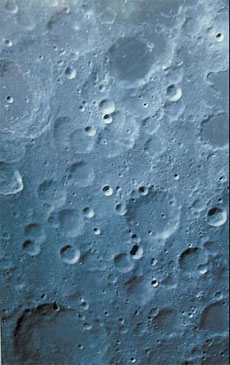China yesterday published the first lunar image captured by orbiter Chang'e I, marking the start of the satellite's mission to document the moon's landscape.
Unveiling the image at the Beijing Aerospace Control Center, Premier Wen Jiabao hailed it as a major step in the Chinese people's "1,000-year-old dream" of exploring the moon.
The black-and-white picture clearly showed a rough moon surface scattered with craters. Sources at the center said the picture covers an area about 460 km long and 280 km wide - about half the size of the United Kingdom.

Based on the raw image data acquired, scientists have also produced a three-dimensional stereo image of the moon, which will be released soon.
In one year, China aims to present to the world "the most detailed, comprehensive map of the moon," said Ouyang Ziyuan, chief scientist of the China Lunar Exploration Program.
Wen said the launch of the lunar probe - the third milestone following the successes of man-made satellites and manned space flights - indicate that China has joined the select few world powers that have the capability to engage in deep-space exploration.
The success not only manifests China's rising national strength and technical innovation, but also elevates the country's international status and cements national cohesion, Wen said.
The premier said the probe's success showed the world that "the Chinese people have the will, confidence and ability to constantly compose fine new chapters as we scale the peaks of modern science and technology".
"The Chinese nation is fully able to stand tall among the world's ranks of advanced nations."
Sun Laiyan, administrator of the China National Space Administration (CNSA), told a press conference yesterday that the success has laid a solid foundation for follow-on scientific exploration and research.
In the second phase of the program, a lunar lander carrying a rover will be launched for a soft landing on the moon and surveys near the landing area. In the third phase, another lunar lander will be sent to collect samples on the moon and bring them back to Earth.
Sun said the project has made many technical breakthroughs, improved China's independent innovation capability, and fostered a group of young scientists in the space industry.
Sun said that the country will eventually send astronauts to the moon, but there is no timetable. Some media had earlier reported 2020 as the likely year.
He stressed that lunar exploration is a scientific and technical program for the peaceful use of outer space.
"We have a very open program and we are willing to cooperate according to common international practices."
In another development, Zhang Chongfeng, a researcher with China Aerospace Science and Technology Corporation, said in an online interview yesterday that the ongoing project will help find an ideal landing spot for the future lunar lander.
Chang'e I, named after a legendary Chinese goddess who flew to the moon, blasted off on a Long March 3A carrier rocket on October 24 from Xichang, Sichuan Province.
Xinhua contributed to the story
(China Daily 11/27/2007 page1)
